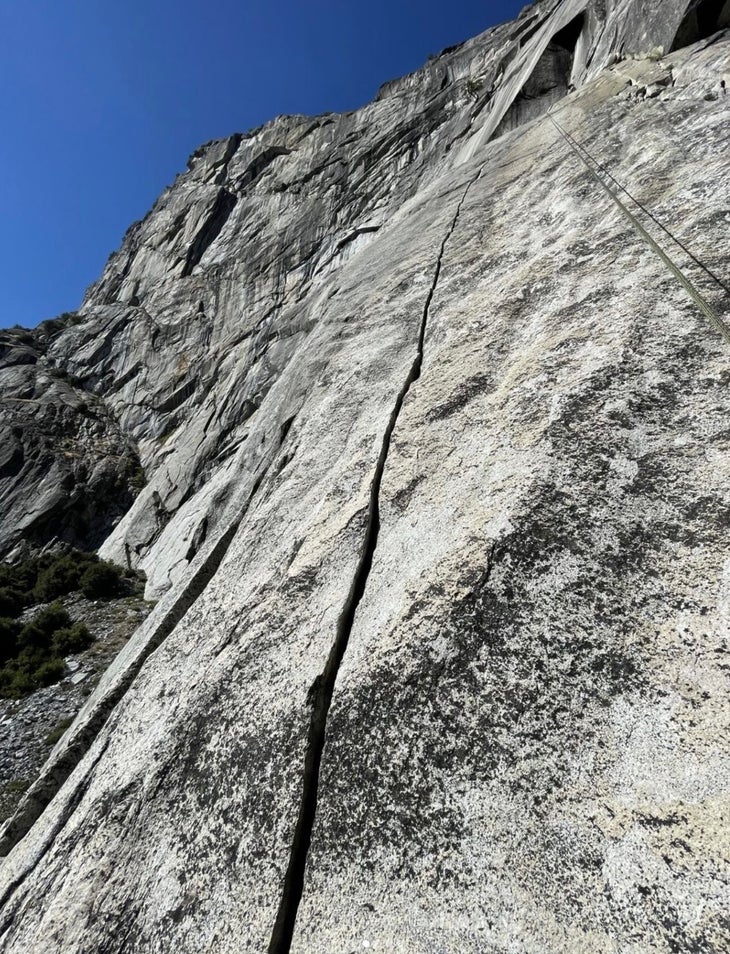No products in the cart.
Outdoor Adventure
New Crack Appears in Yosemite, Closing Popular Trail
Heading out the door? Read this article on the new Outside+ app available now on iOS devices for members!
Download the app.
Last week a 200-foot hand crack appeared overnight near Yosemite’s Royal Arches cliff. The splitter was quickly climbed and named “Super Natural” before park officials closed the classic area.
The park’s closure notice states: “Rock climbers recently reported a new crack in a cliff on the western side of Royal Arches, near the climbing route “Super Slide”. Subsequent investigation revealed that this crack has partially detached a large pillar of rock, and that cracking was actively occurring. As a precautionary effort to reduce risk from rockfall, the National Park Service is implementing a temporary area and trail closure while the area is investigated further.”
Closures include the eastern part of the Ahwahnee Hotel Parking area, extending to the east side of the Royal Arches Creek, the Serenity Crack and Super Slide areas, including Peruvian Flake to the Rhombus Wall, and the Ahwahnee Boulders east of and including the Ahwahnee Boulder.

Jesse McGahey, a Supervisory Park Ranger at Yosemite National Park, told Climbing: “We learned about this [new crack] from a Yosemite Mountain School guide who had climbed up there on August 6th and did not see the crack. And then he climbed it on August 20th and the crack was there. And it was a finger-tips to one-inch sized crack 200 feet long or so.”
Initially, park officials put a notice on Mountain Project but didn’t issue a formal closure until the area could be further evaluated: “…the following week a climbing ranger and a geologist observed it firsthand and they could hear it cracking like a frozen lake that wasn’t consolidated,” McGahey said. “And there were pieces of rock rattling down the crack without touching it. The park geologist said they’d never seen anything like this. He’s never been able to observe that in his 15 years in Yosemite.”
Previous reports from park officials added, “Greg Stock, the park geologist, is currently working on a monitoring plan to see if any more shifting or movement happens with this newly formed crack. Greg and a seasonal climbing ranger recently climbed Super Slide to observe the new crack and heard continuous creaking noises and witnessed many rock chips falling out of the crack. Since its FA, it has expanded over an inch in the past week. It’s hard to predict if this massive piece of stone will fall in the next week, this winter, or last many years. We will keep everyone updated through the climbing stewards Instagram account and other park media platforms with the most current information and results of the geological surveying.”
As of this morning, the crack had grown in length by an additional 12 feet. “It also widened. In a lot of places where you had a tip finger crack, it had widened into baggy ring locks,” said McGahey.
Rockfall is relatively common in the Yosemite Valley. The park’s records show that more than 1,000 significant rockfall incidents have taken place over the past 150 years. It is partially due to this natural process that the park has its unique features. Factors like changing temperatures, moisture levels, and vegetation shifts can contribute to rockfall. Associated injuries and deaths are rare, but not impossible.
According to McGahey, there have been several rock-fall related incidents this year: “We’ve had a fatality, and at least three other accidents that required rescues involving rock failure –all human caused, induced either from people pulling a block off or someone leaning against a block.”
In 2022, two visitors were struck by rockfall after debris came loose just below Union Point and tumbled to the valley floor. And a nearly 50,000 cubic feet slab of rock came loose on Middle Brother, accounting for the largest incident of the year.
Yosemite’s scientists regularly study the threat of rockfall within the park boundaries, utilizing tools like high resolution photography, and laser mapping to assess risks.
McGahey reminds visitors that: “It’s an evolving and ongoing situation and we will continue to monitor it. It’ll remain closed due to the fact that it’s an active crack, and we are observing further propagation or growth of the crack. And also keep in mind that climbers can encounter rockfall on any route in any area of Yosemite.”
Source link

